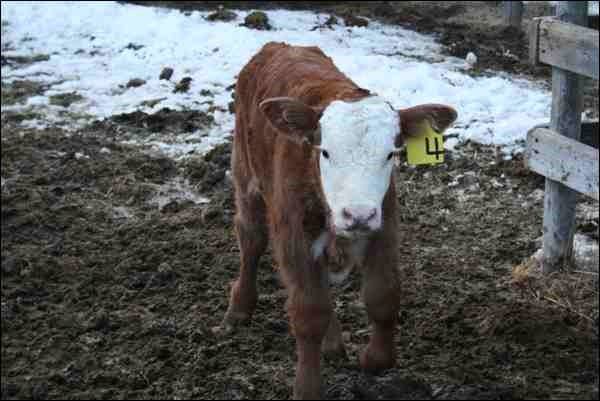It's that time of year; everywhere I look there are calves! Calving time is when the rubber hits the road in the cow business. After all, without a live - and thrifty - calf, there won't be much jingle in your jeans. The following article deals with some things to keep in mind throughout and beyond the calving season.
Colostrum intake is critical for the newborn calf. At birth, a calf's immune system is not fully developed. The calf must rely on colostrum (the first milk) from the cow until its own immune system is fully functional (at about one to two months of age). Colostrum contains antibodies or immunoglobulins necessary to provide the calf protection from disease.
Diarrhea, commonly called scours, is one of the most likely reasons young calves become sick or die. Besides its detriment to calf health and well-being, calf scours is costly to cattle producers due to poor calf performance, death, and the expense of medications and labor to treat sick calves. Scours can be caused by bacteria, viruses or parasites, including and not limited to: coccidia, giardia, and cryptosporidia. It is usually associated with poor sanitation, wet environment, and mixing ill and well animals in the same pen. Providing a clean, dry area for cows that are calving and cow-calf pairs is critical to limiting the spread of disease in newborn calves.
Bovine Viral Diarrhea (BVD) in pregnant animals, can cross the placenta to infect the fetus with different outcomes depending on the stage of pregnancy. Fetal death is common if infection occurs during the first few months of pregnancy. If infection occurs in the first 120 days of pregnancy and the fetus survives, it will be born persistently infected (PI) with the virus. Surviving fetuses will often be born with defects, such as blindness, skeletal problems and poorly developed brains. Infection during the last three months of pregnancy generally does not result in any negative effects to the fetus. PI calves are commonly 'poor doers', less resistant to diseases, and they may develop fatal mucosal disease. They may also appear to be perfectly normal. All PI animals shed very high amounts of virus, contaminating their environment and maintaining a constant source of infection for other animals in the herd.
Respiratory disease such as pneumonia can be caused by bacteria, viruses or mycoplasmas. The most common and earliest recognizable clinical sign of pneumonia is depression. Calves exhibiting depression will have drooping ears, an extended head, a bowed back and/or often isolate themselves from other cattle. Calves with pneumonia will also cough, and often have mucous running from the nose and eyes. You may also hear a 'rattling' noise as they breath.
Blackleg - this disease is normally seen in animals between six months and two years of age. It is a bacterial disease caused by Clostridium chauvoei, which may enter the body through wounds and contaminated feed as active bacteria or spores. Some are normal inhabitants of the intestinal tract, and clostridium can be present in the soil and gain entry through the digestive tract. The bacteria enter the calf by ingestion and then gains entrance to the body through small punctures in the mucous membrane of the digestive tract. Lameness is usually the first sign of the disease, followed by loss of appetite, rapid breathing, high fever and depression. Characteristic swellings (spongy and gaseous) develop in the hip, shoulder, chest, back and neck.
Abomasal ulcers - This syndrome affects young fast-growing calves around the age of three to six weeks. Cattle are born with four stomachs, of which the fourth stomach (abomasum) is the one that most closely resembles a human stomach. Hence, just as in people, the abomasum is prone to developing ulcers. Some of these are subclinical and do not affect the calf, some bleed, while others perforate. Typically, calves with bleeding ulcers will pass digested blood, which makes the feces black in appearance. As for the perforating ulcers, many of these calves have a history of being healthy, but are then found dead or in shock. If a post-mortem is performed, these calves will have a 'dime-sized' hole in the wall of the abomasum, along with a reddened and inflamed abdominal cavity.
Environmental factors such as weather extremes, crowding, predators, and physical sources of injury can present dangers to calves. At birth the calf is limited in its ability to regulate its body temperature so extremely warm or cold environmental conditions present a risk for hyperthermia, or hypothermia, respectively, especially when accompanied by wet and muddy or dry and dusty conditions. Crowded herd conditions increase the chance for injury from being stepped on or butted by others in the herd, and increase the risk of pathogen exposure. Predators present a great risk to calves shortly after birth, or calves weakened by illness or injury. Physical sources of injury include: protruding nails, broken posts, loose wire, holes, steep embankments, standing water, various sources of electricity, and toxins (such as from lead batteries or chemical containers).
Spring is the season of hope. The grass greens, and there's something special about watching calves frolic about!
-Heyden is Regional Livestock Specialist, North Battleford Regional Services Branch

.png;w=120;h=80;mode=crop)


